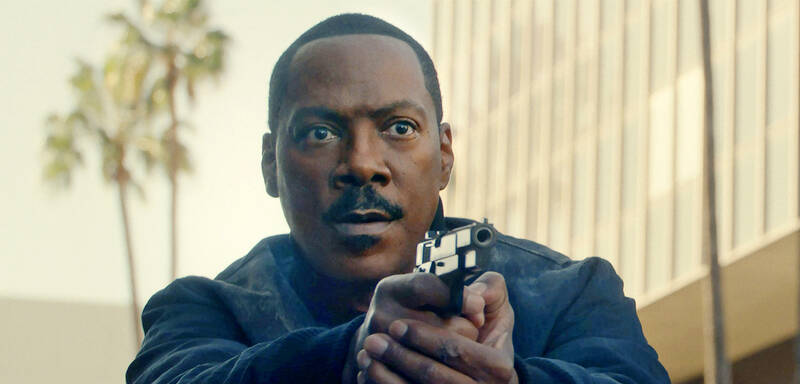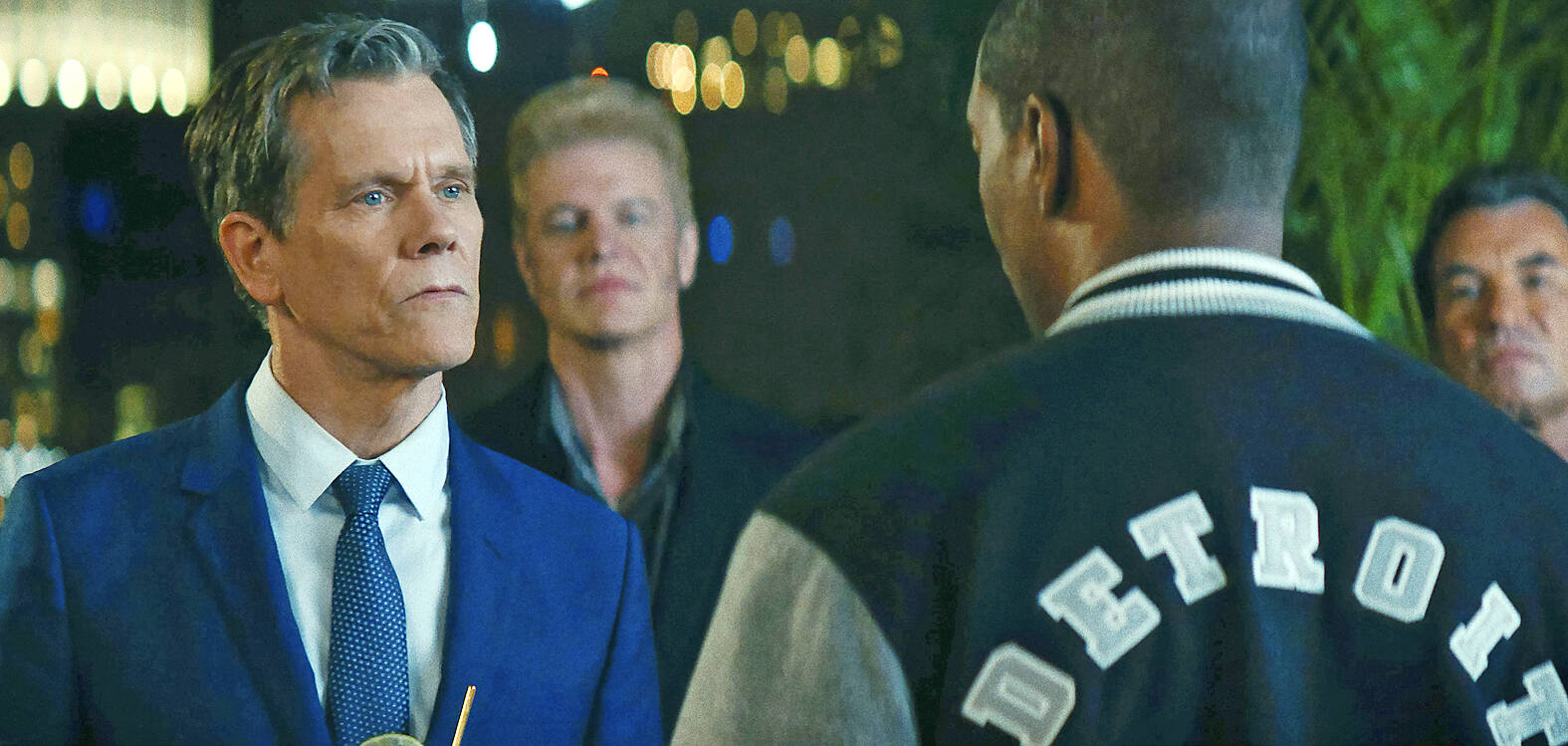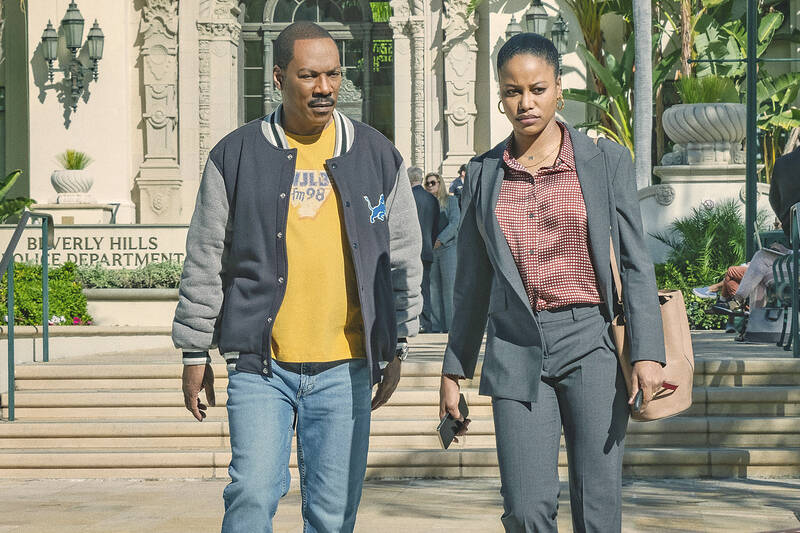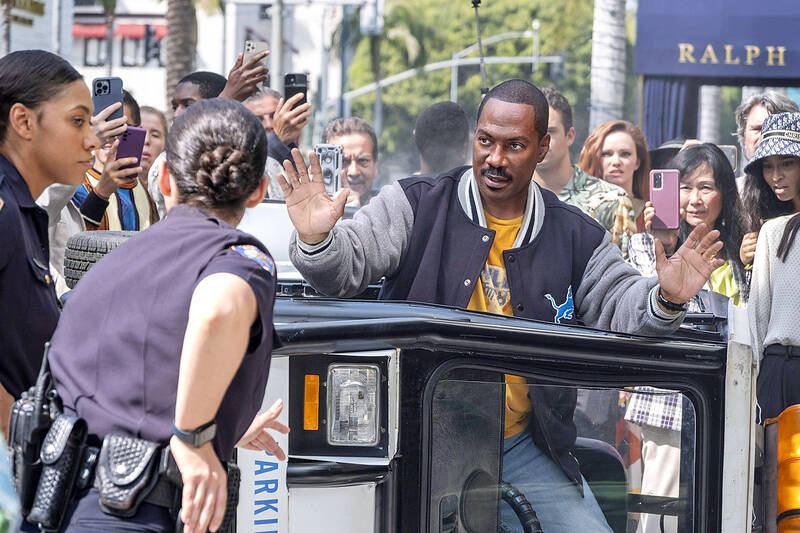Judge Reinhold is in a truck barreling down the highway chased by angry cops when he turns to Eddie Murphy at the wheel and says something we’re all feeling, “God, I missed you, Axel.”
We all really did, but we get the sarcastic and sweet Axel Foley once again in Netflix’s Beverly Hills Cop: Axel F, exactly 30 years since 1994’s Beverly Hills Cop III. Is the new movie any good? Who cares?
The fourth outing brings back not just Murphy and Reinhold to the Axel Foley Cinematic Universe, but also long-time co-stars Paul Reiser, John Ashton and Bronson Pinchot. Kevin Bacon, Taylour Paige and Joseph Gordon-Levitt make their debuts.

Photo: AP
The plot is pretty simple: Murphy’s Foley is living his best cop life in Detroit — destroying things spectacularly — when he’s asked to urgently return to Beverly Hills to help his estranged daughter, played with real grit by Taylour Paige. He then gets caught up in a murder case that has dirty cops and lets him make fun of snooty Beverly Hills.
Newcomers may be puzzled by the slow pace and ‘80s feel of Mark Molloy’s directed sequel. It’s not as funny as previous ones or ambitious in the way sequels for beloved franchises have gotten. But it has Murphy blowing stuff up and joking about it — all we need, really.
“Goddamn, Foley. Here we go again,” says Ashton, playing the exasperated chief of police, and that sentiment runs through the fourth entry. All you need to make your Gen X friends happy is a montage of Murphy behind the wheel while The Heat Is On by Glenn Frey plays. (Neutron Dance by The Pointer Sisters also returns).

Photo: AP
Speaking of music, the filmmakers seem to want to break some sort of record for Most Theme Song Plays in a Single Movie, as the instrumental tune Axel F by Harold Faltermeyer is cued up, by one rough count, approximately 5,000 times.
COMMANDEERING VEHICLES
There are also a lot of vehicles commandeered in Beverly Hills Cop: Axel F, perhaps a nod to the advanced age of the core group. There’s a snowplow, a helicopter, a golf cart and trucks, none of which are returned in mint condition.

Photo: AP
The screenwriters — Will Beall, Tom Gormican and Kevin Etten — leave plenty of places for Murphy to improvise but also craft some surprisingly strong dialogue between Foley and his 32-year-old daughter, both nursing hurt feelings.
“You didn’t fight. I’m your daughter. The only thing you’ve ever fought for is your job,” she tells him. “Look, we both messed this thing up. All right? Let’s just call it even.”
Come for the explosions, stay for the heart-to-hearts.

Photo: AP
Murphy uses Mary J. Blige’s Family Affair and proves it. In one scene, Foley is arrested while trying to drive away in a comically small cop car. One of the traffic cops is played by Murphy’s daughter, Bria, one of his 10 kids. Another cop who later tases him is a son-in-law.
A lot has changed in the three decades since Foley was breaking rules and skulls and there’s the feeling of a requiem as these aged men go into battle again.
“They don’t want swashbucklers out there anymore. They want social workers,” Reiser’s detective says.
There are jokes about Wesley Snipes, small yappy dogs and Spirit airlines, a scary shootout on Wilshire Boulevard, way too much synth played and an inside joke about the last sequel, a stinker: Gordon-Levitt goes through all of Foley’s brushes with the California police and says “‘94, not your finest hour.”
Axel F is not exactly Murphy’s finest hour, either. But Murphy just saying “Jesus!” is funny. Let’s hope we don’t have to wait another 30 years for our next Axel Foley fix. God, we’ve missed him.

The canonical shot of an East Asian city is a night skyline studded with towering apartment and office buildings, bright with neon and plastic signage, a landscape of energy and modernity. Another classic image is the same city seen from above, in which identical apartment towers march across the city, spilling out over nearby geography, like stylized soldiers colonizing new territory in a board game. Densely populated dynamic conurbations of money, technological innovation and convenience, it is hard to see the cities of East Asia as what they truly are: necropolises. Why is this? The East Asian development model, with

June 16 to June 22 The following flyer appeared on the streets of Hsinchu on June 12, 1895: “Taipei has already fallen to the Japanese barbarians, who have brought great misery to our land and people. We heard that the Japanese occupiers will tax our gardens, our houses, our bodies, and even our chickens, dogs, cows and pigs. They wear their hair wild, carve their teeth, tattoo their foreheads, wear strange clothes and speak a strange language. How can we be ruled by such people?” Posted by civilian militia leader Wu Tang-hsing (吳湯興), it was a call to arms to retake

Desperate dads meet in car parks to exchange packets; exhausted parents slip it into their kids’ drinks; families wait months for prescriptions buy it “off label.” But is it worth the risk? “The first time I gave him a gummy, I thought, ‘Oh my God, have I killed him?’ He just passed out in front of the TV. That never happens.” Jen remembers giving her son, David, six, melatonin to help him sleep. She got them from a friend, a pediatrician who gave them to her own child. “It was sort of hilarious. She had half a tub of gummies,

The wide-screen spectacle of Formula One gets a gleaming, rip-roaring workout in Joseph Kosinski’s F1, a fine-tuned machine of a movie that, in its most riveting racing scenes, approaches a kind of high-speed splendor. Kosinski, who last endeavored to put moviegoers in the seat of a fighter jet in Top Gun: Maverick, has moved to the open cockpits of Formula One with much the same affection, if not outright need, for speed. A lot of the same team is back. Jerry Bruckheimer produces. Ehren Kruger, a co-writer on Maverick, takes sole credit here. Hans Zimmer, a co-composer previously, supplies the thumping